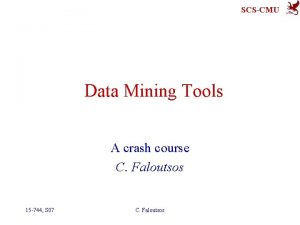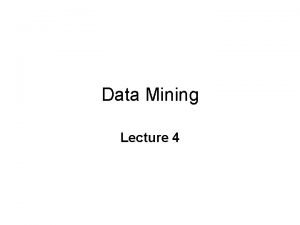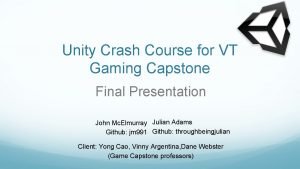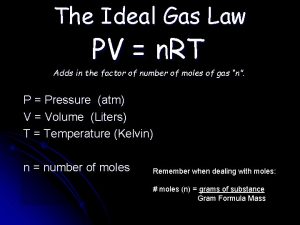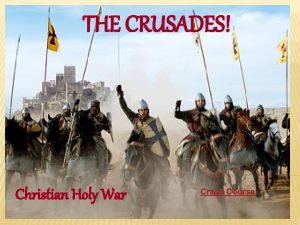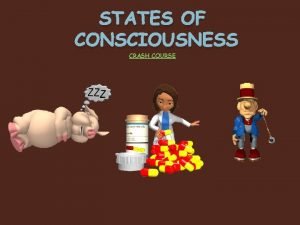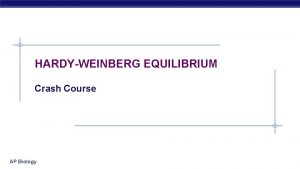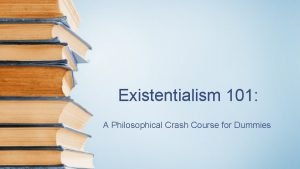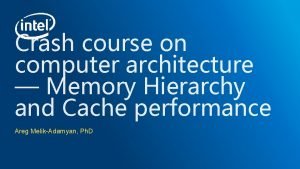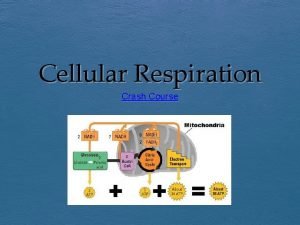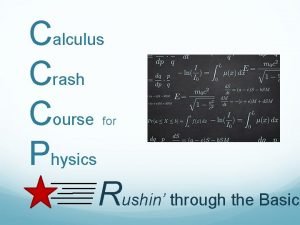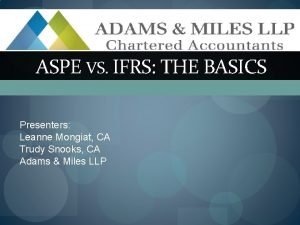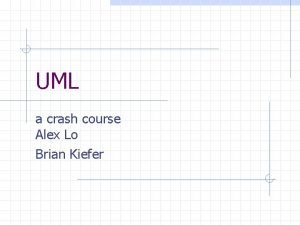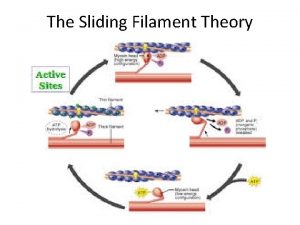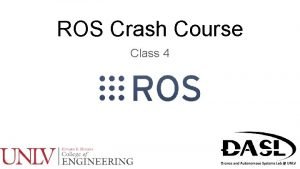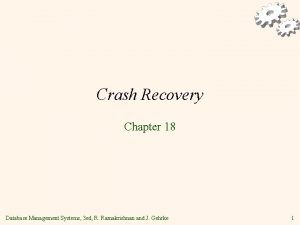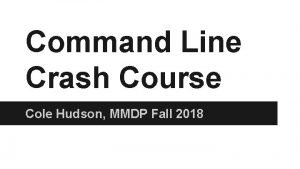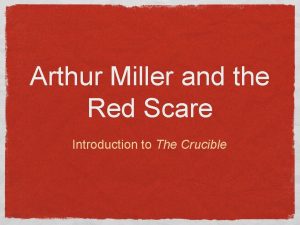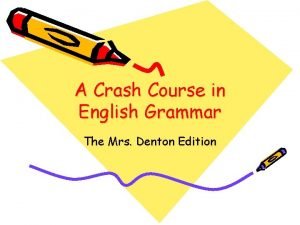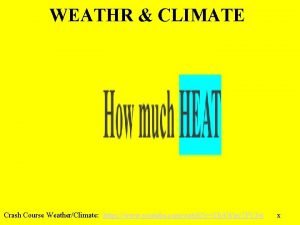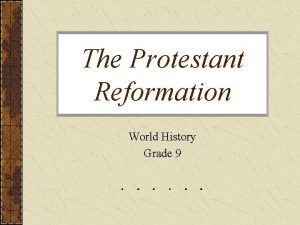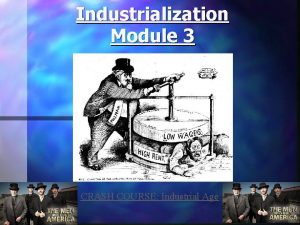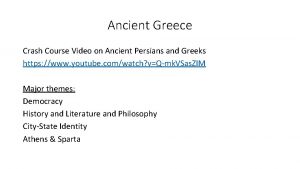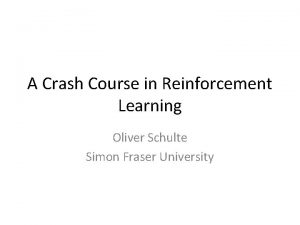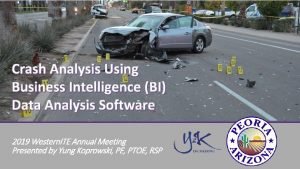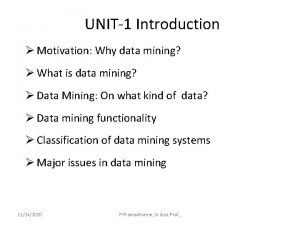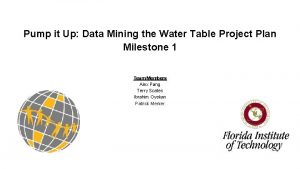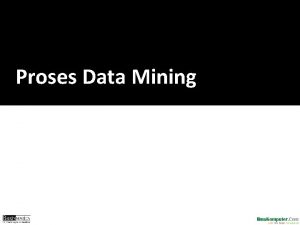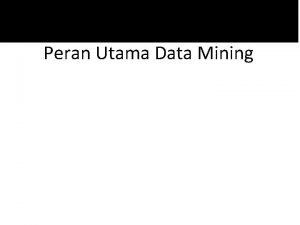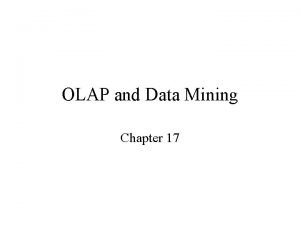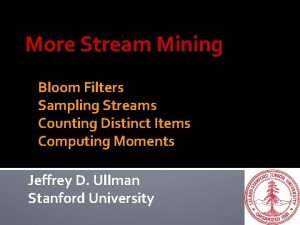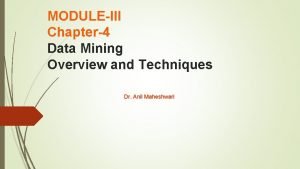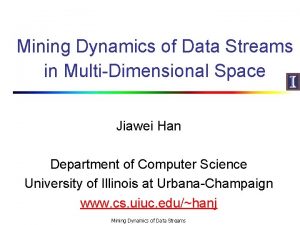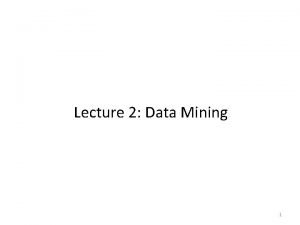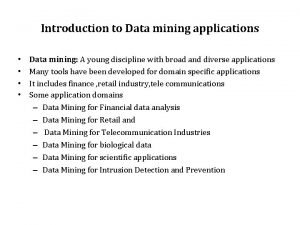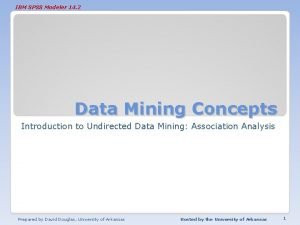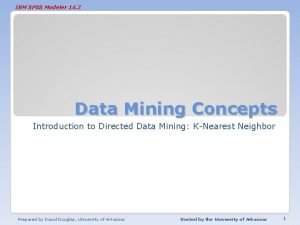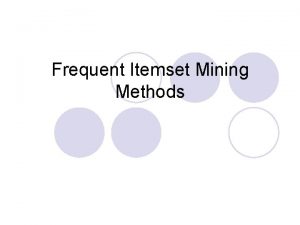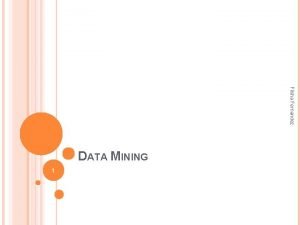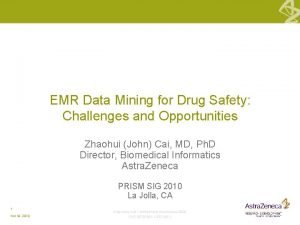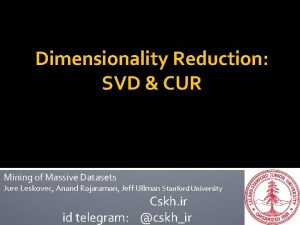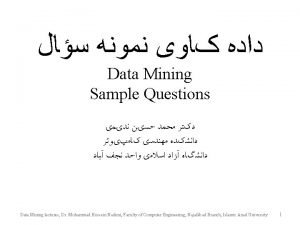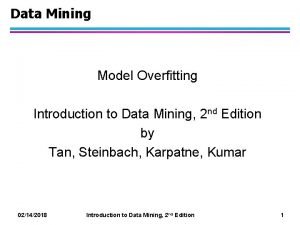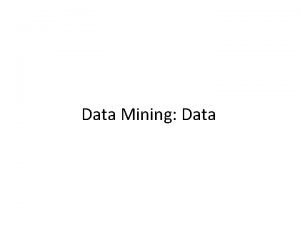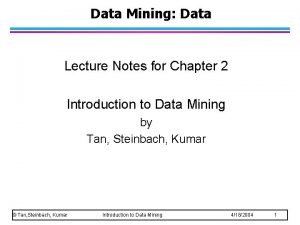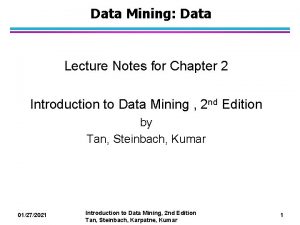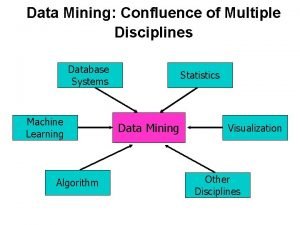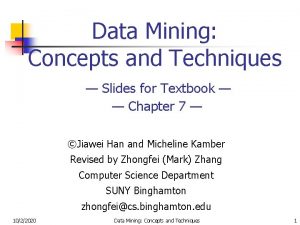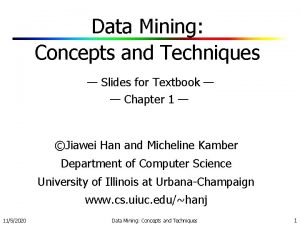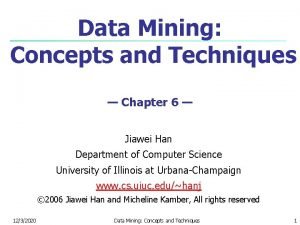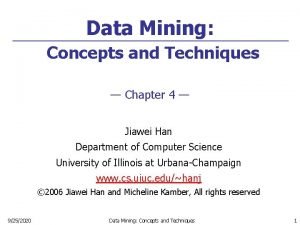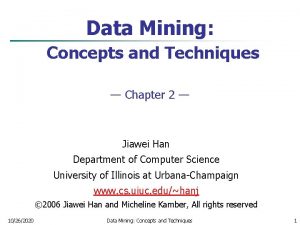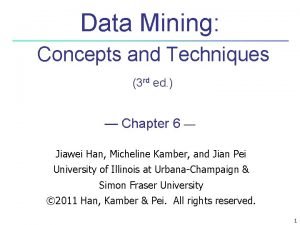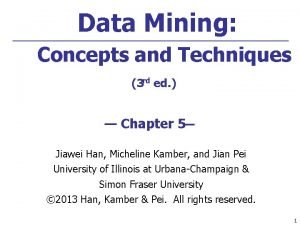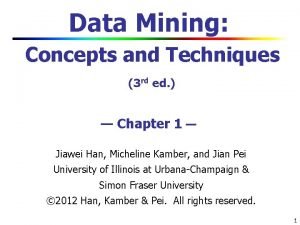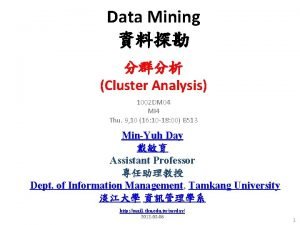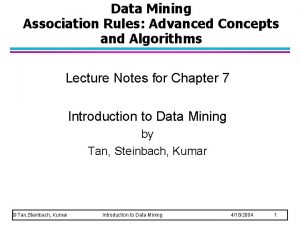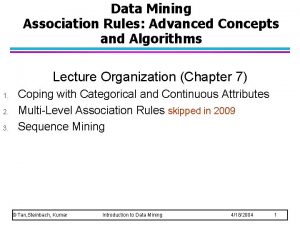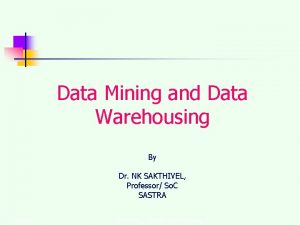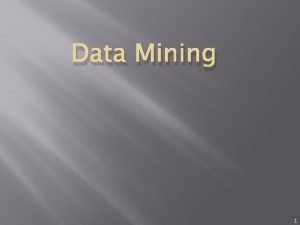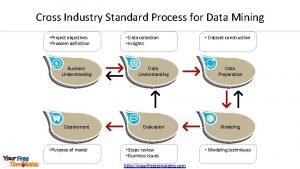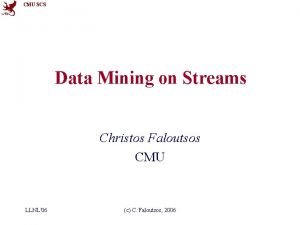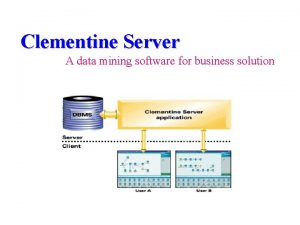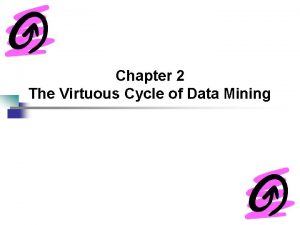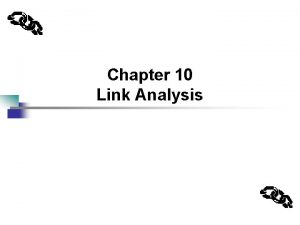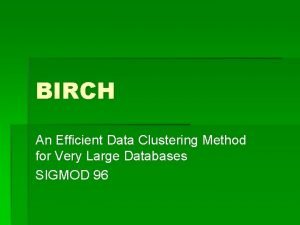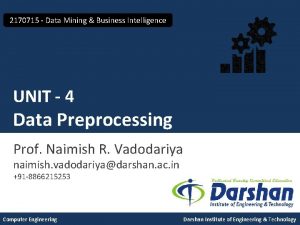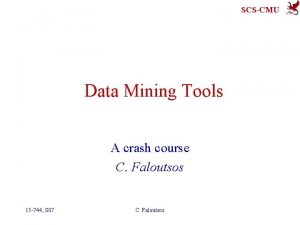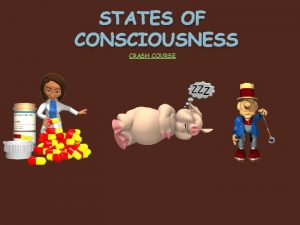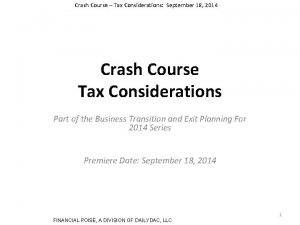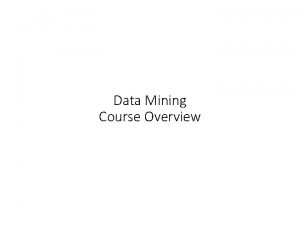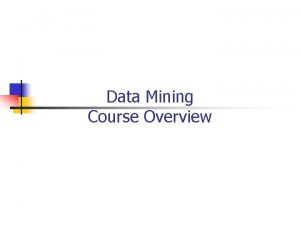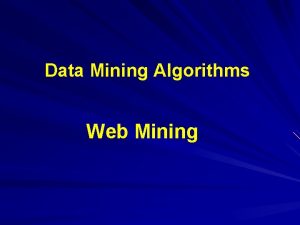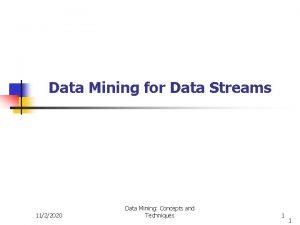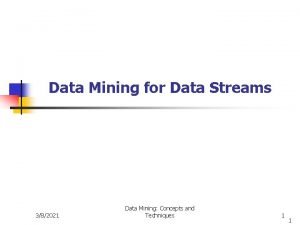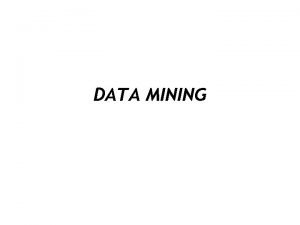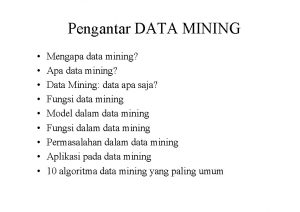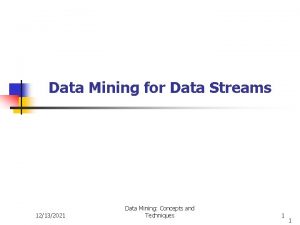SCSCMU Data Mining Tools A crash course C












![SCS-CMU SVD - Definition A[n x m] = U[n x r] L [ r SCS-CMU SVD - Definition A[n x m] = U[n x r] L [ r](https://slidetodoc.com/presentation_image_h/873531124835af0943afb5ce15372d00/image-13.jpg)
![SCS-CMU SVD - Properties THEOREM [Press+92]: always possible to decompose matrix A into A SCS-CMU SVD - Properties THEOREM [Press+92]: always possible to decompose matrix A into A](https://slidetodoc.com/presentation_image_h/873531124835af0943afb5ce15372d00/image-14.jpg)















































![SCS-CMU Books • [Press+92] William H. Press, Saul A. Teukolsky, William T. Vetterling and SCS-CMU Books • [Press+92] William H. Press, Saul A. Teukolsky, William T. Vetterling and](https://slidetodoc.com/presentation_image_h/873531124835af0943afb5ce15372d00/image-62.jpg)

![SCS-CMU Additional Reading • [Foltz+92] Foltz, P. W. and S. T. Dumais (Dec. 1992). SCS-CMU Additional Reading • [Foltz+92] Foltz, P. W. and S. T. Dumais (Dec. 1992).](https://slidetodoc.com/presentation_image_h/873531124835af0943afb5ce15372d00/image-64.jpg)































![SCS-CMU Solution #1: traffic • disk traces: self-similar: (also: [Leland+94]) • How to generate SCS-CMU Solution #1: traffic • disk traces: self-similar: (also: [Leland+94]) • How to generate](https://slidetodoc.com/presentation_image_h/873531124835af0943afb5ce15372d00/image-96.jpg)
![SCS-CMU Solution #1: traffic • disk traces (80 -20 ‘law’ = ‘multifractal’) [Riedi+99], [Wang+02] SCS-CMU Solution #1: traffic • disk traces (80 -20 ‘law’ = ‘multifractal’) [Riedi+99], [Wang+02]](https://slidetodoc.com/presentation_image_h/873531124835af0943afb5ce15372d00/image-97.jpg)


![SCS-CMU How to estimate p? • A: entropy plot [Wang+’ 02] • [~ correlation SCS-CMU How to estimate p? • A: entropy plot [Wang+’ 02] • [~ correlation](https://slidetodoc.com/presentation_image_h/873531124835af0943afb5ce15372d00/image-100.jpg)




![SCS-CMU Solution#3: spatial d. m. Galaxies ( ‘BOPS’ plot - [sigmod 2000]) log(#pairs(<=r)) log(r) SCS-CMU Solution#3: spatial d. m. Galaxies ( ‘BOPS’ plot - [sigmod 2000]) log(#pairs(<=r)) log(r)](https://slidetodoc.com/presentation_image_h/873531124835af0943afb5ce15372d00/image-105.jpg)



![SCS-CMU Power laws, cont’ed • In- and out-degree distribution of web sites [Barabasi], [IBM-CLEVER] SCS-CMU Power laws, cont’ed • In- and out-degree distribution of web sites [Barabasi], [IBM-CLEVER]](https://slidetodoc.com/presentation_image_h/873531124835af0943afb5ce15372d00/image-109.jpg)





![SCS-CMU Fractals: Medical images [Burdett et al, SPIE ‘ 93]: • benign tumors: fd SCS-CMU Fractals: Medical images [Burdett et al, SPIE ‘ 93]: • benign tumors: fd](https://slidetodoc.com/presentation_image_h/873531124835af0943afb5ce15372d00/image-115.jpg)













![SCS-CMU Further reading: • [Barabasi+] Reka Albert, Hawoong Jeong, and Albert. Laszlo Barabasi, Diameter SCS-CMU Further reading: • [Barabasi+] Reka Albert, Hawoong Jeong, and Albert. Laszlo Barabasi, Diameter](https://slidetodoc.com/presentation_image_h/873531124835af0943afb5ce15372d00/image-129.jpg)
![SCS-CMU Further reading: • [sigcomm 99] Michalis Faloutsos, Petros Faloutsos and Christos Faloutsos, What SCS-CMU Further reading: • [sigcomm 99] Michalis Faloutsos, Petros Faloutsos and Christos Faloutsos, What](https://slidetodoc.com/presentation_image_h/873531124835af0943afb5ce15372d00/image-130.jpg)
![SCS-CMU Further reading • [Montgomery+01] A. Montgomery and C. Faloutsos, Identifying Web Browsing Trends SCS-CMU Further reading • [Montgomery+01] A. Montgomery and C. Faloutsos, Identifying Web Browsing Trends](https://slidetodoc.com/presentation_image_h/873531124835af0943afb5ce15372d00/image-131.jpg)
![SCS-CMU Further reading • [Riedi+99] R. H. Riedi, M. S. Crouse, V. J. Ribeiro, SCS-CMU Further reading • [Riedi+99] R. H. Riedi, M. S. Crouse, V. J. Ribeiro,](https://slidetodoc.com/presentation_image_h/873531124835af0943afb5ce15372d00/image-132.jpg)

- Slides: 133

SCS-CMU Data Mining Tools A crash course C. Faloutsos 15 -744, S 07 C. Faloutsos

SCS-CMU Subset of: www. cs. cmu. edu/~christos/TALKS/ SIGMETRICS 03 -tut/ 15 -744, S 07 C. Faloutsos 2

SCS-CMU High-level Outline • [I - Traditional Data Mining tools – classification, CART trees; clustering • II - Time series: analysis and forecasting – ARIMA; Fourier, Wavelets] • III - New Tools: SVD • IV - New Tools: Fractals & power laws 15 -744, S 07 C. Faloutsos 3

SCS-CMU High-level Outline • • [I - Traditional Data Mining tools II - Time series: analysis and forecasting] III - New Tools: SVD IV - New Tools: Fractals & power laws 15 -744, S 07 C. Faloutsos 4

SCS-CMU III - SVD - outline • • • Introduction - motivating problems Definition - properties Interpretation / Intuition Solutions to posed problems Conclusions 15 -744, S 07 C. Faloutsos 5

SCS-CMU SVD - Motivation • problem #1: find patterns in a matrix – (e. g. , traffic patterns from several IP-sources) – compression; dim. reduction 15 -744, S 07 C. Faloutsos 6

SCS-CMU Problem#1 • ~10**6 rows; ~10**3 columns; no updates; • Compress / find patterns 15 -744, S 07 C. Faloutsos 7

SCS-CMU SVD - in short: It gives the best hyperplane to project on 15 -744, S 07 C. Faloutsos 8

SCS-CMU SVD - in short: It gives the best hyperplane to project on 15 -744, S 07 C. Faloutsos 9

SCS-CMU III - SVD - outline • • • Introduction - motivating problems Definition - properties Interpretation / Intuition Solutions to posed problems Conclusions 15 -744, S 07 C. Faloutsos 10

SCS-CMU SVD - Definition • A = U L VT - example: 15 -744, S 07 C. Faloutsos 11

SCS-CMU SVD - notation Conventions: • bold capitals -> matrix (eg. A, U, L, V) • bold lower-case -> column vector (eg. , x, v 1, u 3) • regular lower-case -> scalars (eg. , l 1 , lr ) 15 -744, S 07 C. Faloutsos 12
![SCSCMU SVD Definition An x m Un x r L r SCS-CMU SVD - Definition A[n x m] = U[n x r] L [ r](https://slidetodoc.com/presentation_image_h/873531124835af0943afb5ce15372d00/image-13.jpg)
SCS-CMU SVD - Definition A[n x m] = U[n x r] L [ r x r] (V[m x r])T • A: n x m matrix (eg. , n customers, m days) • U: n x r matrix (n customers, r concepts) • L: r x r diagonal matrix (strength of each ‘concept’) (r : rank of the matrix) • V: m x r matrix (m days, r concepts) 15 -744, S 07 C. Faloutsos 13
![SCSCMU SVD Properties THEOREM Press92 always possible to decompose matrix A into A SCS-CMU SVD - Properties THEOREM [Press+92]: always possible to decompose matrix A into A](https://slidetodoc.com/presentation_image_h/873531124835af0943afb5ce15372d00/image-14.jpg)
SCS-CMU SVD - Properties THEOREM [Press+92]: always possible to decompose matrix A into A = U L VT , where • U, L, V: unique (*) • U, V: column orthonormal (ie. , columns are unit vectors, orthogonal to each other) – UT U = I; VT V = I (I: identity matrix) • L: eigenvalues are positive, and sorted in decreasing order 15 -744, S 07 C. Faloutsos 14

SCS-CMU SVD - example • Customers; days; #packets Comm. Res. 15 -744, S 07 C. Faloutsos 15

SCS-CMU SVD - Example • A = U L VT - example: Fr We Th. Sa. Su Com. = x x Res. 15 -744, S 07 C. Faloutsos 16

SCS-CMU III - SVD - outline • Introduction - motivating problems • Definition - properties • Interpretation / Intuition – #1: customers, days, concepts – #2: best projection - dimensionality reduction • Solutions to posed problems • Conclusions 15 -744, S 07 C. Faloutsos 17

SCS-CMU SVD - Interpretation #1 ‘customers’, ‘days’ and ‘concepts’ • U: customer-to-concept similarity matrix • V: day-to-concept sim. matrix • L: its diagonal elements: ‘strength’ of each concept 15 -744, S 07 C. Faloutsos 18

SCS-CMU SVD - Interpretation #1 • A = U L VT - example: Fr We Th. Rank=2 Sa. Su 2 x 2 Com. = x x Res. 15 -744, S 07 C. Faloutsos 19

SCS-CMU SVD - Interpretation #1 • A = U L VT - example: Fr We Th. Rank=2 =2 ‘concepts’ Sa. Su Com. = x x Res. 15 -744, S 07 C. Faloutsos 20

SCS-CMU (reminder) • Customers; days; #packets Comm. Res. 15 -744, S 07 C. Faloutsos 21

SCS-CMU SVD - Interpretation #1 • A = U L VT - example: We U: customer-to-concept similarity matrix Fr weekday-concept Th. W/end-concept Sa. Su Com. = x x Res. 15 -744, S 07 C. Faloutsos 22

SCS-CMU SVD - Interpretation #1 • A = U L VT - example: We U: Customer to concept similarity matrix Fr weekday-concept Th. W/end-concept Sa. Su Com. = x x Res. 15 -744, S 07 C. Faloutsos 23

SCS-CMU SVD - Interpretation #1 • A = U L VT - example: Fr We Th. unit Sa. Su Com. = x x Res. 15 -744, S 07 C. Faloutsos 24

SCS-CMU SVD - Interpretation #1 • A = U L VT - example: Fr We Th. weekday-concept Sa. Su Com. = x Strength of ‘weekday’ concept x Res. 15 -744, S 07 C. Faloutsos 25

SCS-CMU SVD - Interpretation #1 • A = U L VT - example: Fr We Th. weekday-concept Sa. Su Com. = x V: day to concept similarity matrix x Res. 15 -744, S 07 C. Faloutsos 26

SCS-CMU III - SVD - outline • Introduction - motivating problems • Definition - properties • Interpretation / Intuition – #1: customers, days, concepts – #2: best projection - dimensionality reduction • Solutions to posed problems • Conclusions 15 -744, S 07 C. Faloutsos 27

SCS-CMU SVD - Interpretation #2 • best axis to project on: (‘best’ = min sum of squares of projection errors) 15 -744, S 07 C. Faloutsos 28

SCS-CMU SVD - Interpretation #2 15 -744, S 07 C. Faloutsos 29

SCS-CMU SVD - Interpretation#2 15 -744, S 07 C. Faloutsos 30

SCS-CMU SVD - interpretation #2 SVD: gives best axis to project v 1 • minimum RMS error 15 -744, S 07 C. Faloutsos 31

SCS-CMU SVD - Interpretation #2 • A = U L VT - example: = x x v 1 15 -744, S 07 C. Faloutsos 32

SCS-CMU SVD - Interpretation #2 • A = U L VT - example: variance (‘spread’) on the v 1 axis = 15 -744, S 07 x C. Faloutsos x 33

SCS-CMU SVD - interpretation #2 SVD: gives best axis to project v 1 ~ l 1 • minimum RMS error 15 -744, S 07 C. Faloutsos 34

SCS-CMU SVD, PCA and the v vectors • how to ‘read’ the v vectors (= principal components) 15 -744, S 07 C. Faloutsos 35

SCS-CMU SVD • Recall: A = U L VT - example: = 15 -744, S 07 x C. Faloutsos x 36

SCS-CMU SVD • First Principal component = v 1 -> weekdays are correlated positively • similarly for v 2 We • (we’ll see negative Th correlations later) Fr Sa Su 15 -744, S 07 C. Faloutsos v 1 v 2 37

SCS-CMU SVD - Complexity • O( n * m) or O( n * m) (whichever is less) • less work, if we just want eigenvalues • . . . or if we want first k eigenvectors • . . . or if the matrix is sparse [Berry] • Implemented: in any linear algebra package (LINPACK, matlab, Splus, mathematica. . . ) 15 -744, S 07 C. Faloutsos 38

SCS-CMU SVD - conclusions so far • SVD: A= U L VT : unique (*) • U: row-to-concept similarities • V: column-to-concept similarities • L: strength of each concept (*) see [Press+92] 15 -744, S 07 C. Faloutsos 39

SCS-CMU SVD - conclusions so far • dim. reduction: keep the first few strongest eigenvalues (80 -90% of ‘energy’ [Fukunaga]) • SVD: picks up linear correlations 15 -744, S 07 C. Faloutsos 40

SCS-CMU III - SVD - outline • • Introduction - motivating problems Definition - properties Interpretation / Intuition Solutions to posed problems – P 1: patterns in a matrix; compression • Conclusions 15 -744, S 07 C. Faloutsos 41

SCS-CMU SVD & visualization: • Visualization for free! – Time-plots are not enough: 15 -744, S 07 C. Faloutsos 42

SCS-CMU SVD & visualization: • Visualization for free! – Time-plots are not enough: 15 -744, S 07 C. Faloutsos 43

SCS-CMU SVD & visualization • SVD: project 365 -d vectors to best 2 dimensions, and plot: • no Gaussian clusters; Zipf -like distribution phonecalls 15 -744, S 07 C. Faloutsos 44

SCS-CMU SVD and visualization NBA dataset ~500 players; ~30 attributes (#games, #points, #rebounds, …) 15 -744, S 07 C. Faloutsos 45

SCS-CMU SVD and visualization could be network dataset: – N IP sources – k attributes (#http bytes, #http packets) 15 -744, S 07 C. Faloutsos 46

SCS-CMU Moreover, PCA/rules for free! • • SVD ~ PCA = Principal component analysis PCA: get eigenvectors v 1, v 2, . . . ignore entries with small abs. value try to interpret the rest 15 -744, S 07 C. Faloutsos 47

SCS-CMU PCA & Rules NBA dataset - V matrix (term to ‘concept’ similarities) 15 -744, S 07 v 1 C. Faloutsos 48

SCS-CMU PCA & Rules • (Ratio) Rule#1: minutes: points = 2: 1 • corresponding concept? v 1 15 -744, S 07 C. Faloutsos 49

SCS-CMU PCA & Rules • • RR 1: minutes: points = 2: 1 corresponding concept? A: ‘goodness’ of player (in a systems setting, could be ‘volume of traffic’ generated by this IP address) 15 -744, S 07 C. Faloutsos 50

SCS-CMU PCA & Rules • RR 2: points: rebounds negatively correlated(!) 15 -744, S 07 C. Faloutsos 51

SCS-CMU PCA & Rules • RR 2: points: rebounds negatively correlated(!) - concept? v 2 15 -744, S 07 C. Faloutsos 52

SCS-CMU PCA & Rules • RR 2: points: rebounds negatively correlated(!) - concept? • A: position: offensive/defensive • (in a network setting, could be e-mailers versus gnutella-users) 15 -744, S 07 C. Faloutsos 53

SCS-CMU III - SVD - outline • • Introduction - motivating problems Definition - properties Interpretation / Intuition Solutions to posed problems – P 1: patterns in a matrix; compression • Conclusions 15 -744, S 07 C. Faloutsos 54

SCS-CMU SVD - conclusions SVD: a valuable tool , whenever we have a matrix, e. g. • many time sequences • many feature vectors • graph (-> adjacency matrix) 15 -744, S 07 C. Faloutsos 55

SCS-CMU SVD - conclusions SVD: a valuable tool , whenever we have a #packets matrix, e. g. on day 2 #packets • many time sequences. . . – SVD finds groups – principal components – dim. reduction 15 -744, S 07 C. Faloutsos on day 1 IP address 2 IP address 3. . . 56

SCS-CMU SVD - conclusions SVD: a valuable tool , whenever we have a matrix, e. g. #bytes sent • feature vectors #packets. . . – SVD finds groups – principal components – (Ratio) Rules – visualization 15 -744, S 07 C. Faloutsos sent lost IP address 1 IP address 2 IP address 3. . . 57

SCS-CMU SVD - conclusions SVD: a valuable tool , whenever we have a matrix, e. g. Dest. router 2 Dest. • adjacency matrix Dest. . – source, dest, bandwidth – SVD -> ‘most central node’ router 1 router 3 Source router 1 Source router 2 Source router 3. . . 15 -744, S 07 C. Faloutsos 58

SCS-CMU SVD - conclusions - cont’d Has been used/re-invented many times: • LSI (Latent Semantic Indexing) [Foltz+92] • PCA (Principal Component Analysis) [Jolliffe 86] • KL (Karhunen-Loeve Transform) • Mahalanobis distance • . . . 15 -744, S 07 C. Faloutsos 59

SCS-CMU Resources: Software and urls • SVD packages: in many systems (matlab, mathematica, LINPACK, LAPACK) • stand-alone, free code: SVDPACK from Michael Berry http: //www. cs. utk. edu/~berry/projects. html 15 -744, S 07 C. Faloutsos 60

SCS-CMU Books • Faloutsos, C. (1996). Searching Multimedia Databases by Content, Kluwer Academic Inc. • Jolliffe, I. T. (1986). Principal Component Analysis, Springer Verlag. 15 -744, S 07 C. Faloutsos 61
![SCSCMU Books Press92 William H Press Saul A Teukolsky William T Vetterling and SCS-CMU Books • [Press+92] William H. Press, Saul A. Teukolsky, William T. Vetterling and](https://slidetodoc.com/presentation_image_h/873531124835af0943afb5ce15372d00/image-62.jpg)
SCS-CMU Books • [Press+92] William H. Press, Saul A. Teukolsky, William T. Vetterling and Brian P. Flannery: Numerical Recipes in C, Cambridge University Press, 1992, 2 nd Edition. (Great description, intuition and code for SVD) 15 -744, S 07 C. Faloutsos 62

SCS-CMU Additional Reading • Berry, Michael: http: //www. cs. utk. edu/~lsi/ • Brin, S. and L. Page (1998). Anatomy of a Large. Scale Hypertextual Web Search Engine. 7 th Intl World Wide Web Conf. 15 -744, S 07 C. Faloutsos 63
![SCSCMU Additional Reading Foltz92 Foltz P W and S T Dumais Dec 1992 SCS-CMU Additional Reading • [Foltz+92] Foltz, P. W. and S. T. Dumais (Dec. 1992).](https://slidetodoc.com/presentation_image_h/873531124835af0943afb5ce15372d00/image-64.jpg)
SCS-CMU Additional Reading • [Foltz+92] Foltz, P. W. and S. T. Dumais (Dec. 1992). "Personalized Information Delivery: An Analysis of Information Filtering Methods. " Comm. of ACM (CACM) 35(12): 51 -60. 15 -744, S 07 C. Faloutsos 64

SCS-CMU Additional Reading • Fukunaga, K. (1990). Introduction to Statistical Pattern Recognition, Academic Press. • Kleinberg, J. (1998). Authoritative sources in a hyperlinked environment. Proc. 9 th ACM-SIAM Symposium on Discrete Algorithms. 15 -744, S 07 C. Faloutsos 65

SCS-CMU Additional Reading • Korn, F. , H. V. Jagadish, et al. (May 13 -15, 1997). Efficiently Supporting Ad Hoc Queries in Large Datasets of Time Sequences. ACM SIGMOD, Tucson, AZ. • Korn, F. , A. Labrinidis, et al. (2000). "Quantifiable Data Mining Using Ratio Rules. " VLDB Journal 8(3 -4): 254 -266. 15 -744, S 07 C. Faloutsos 66

SCS-CMU 15 -744, S 07 C. Faloutsos 67

SCS-CMU High-level Outline • • I - Traditional Data Mining tools II - Time series: analysis and forecasting III - New Tools: SVD IV - New Tools: Fractals & power laws 15 -744, S 07 C. Faloutsos 68

SCS-CMU IV - Fractals - outline • • • Motivation – 3 problems / case studies Definition of fractals and power laws Fast Estimation of fractal dimension Solutions to posed problems More examples and tools Conclusions – practitioner’s guide 15 -744, S 07 C. Faloutsos 69

SCS-CMU Problem #0: GIS - points Road end-points of Montgomery county: • Q 1: # neighbors(r)? • Q 2 : distribution? • not uniform • not Gaussian • no rules? ? 15 -744, S 07 C. Faloutsos 70

SCS-CMU Problem #0: GIS - points (could be: geo-locations of IP addresses launching DDo. S attack) 15 -744, S 07 C. Faloutsos 71

SCS-CMU Problem #1: traffic • disk trace (from HP - J. Wilkes); Web traffic fit a model #bytes Poisson - queue length distr. ? time 15 -744, S 07 - how many explosions to expect? C. Faloutsos 72

SCS-CMU Problem #1’: traffic • Kb per unit time (requests on a web server) http: //repository. cs. vt. edu/ 15 -744, S 07 C. Faloutsos lbl-conn-7. tar. Z 73

SCS-CMU Problem #2 - topology How does the Internet look like? 15 -744, S 07 C. Faloutsos 74

SCS-CMU Problem #3 - spatial d. m. Galaxies (Sloan Digital Sky Survey w/ B. Nichol) - ‘spiral’ and ‘elliptical’ galaxies - patterns? - attraction/repulsion? - separable? 15 -744, S 07 C. Faloutsos 75

SCS-CMU Problem #3 - spatial d. m. . Avg packet rate - ‘good’ and ‘bad’ IP addresses - or ‘read’ and ‘write’ requests - can we separate them? Avg packet size 15 -744, S 07 C. Faloutsos 76

SCS-CMU Common answer: Fractals / self-similarities / power laws 15 -744, S 07 C. Faloutsos 77

SCS-CMU IV - Fractals - outline • • • Motivation – 3 problems / case studies Definition of fractals and power laws Fast Estimation of fractal dimension Solutions to posed problems More examples and tools Conclusions – practitioner’s guide 15 -744, S 07 C. Faloutsos 78

SCS-CMU What is a fractal? = self-similar point set, e. g. , Sierpinski triangle: . . . 15 -744, S 07 C. Faloutsos zero area; infinite length! 79

SCS-CMU Definitions (cont’d) • Paradox: Infinite perimeter ; Zero area! • ‘dimensionality’: between 1 and 2 • actually: Log(3)/Log(2) = 1. 58. . . 15 -744, S 07 C. Faloutsos 80

SCS-CMU Dfn of fd: ONLY for a perfectly self-similar point set: . . . zero area; infinite length! =log(n)/log(f) = log(3)/log(2) = 1. 58 15 -744, S 07 C. Faloutsos 81

SCS-CMU Intrinsic (‘fractal’) dimension • Q: fractal dimension of a line? • A: 1 (= log(2)/log(2)!) 15 -744, S 07 C. Faloutsos 82

SCS-CMU Intrinsic (‘fractal’) dimension • Q: fractal dimension of a line? • A: 1 (= log(2)/log(2)!) 15 -744, S 07 C. Faloutsos 83

SCS-CMU Intrinsic (‘fractal’) dimension • Q: dfn for a given set of points? 15 -744, S 07 C. Faloutsos x y 5 1 4 2 3 3 2 4 84

SCS-CMU Intrinsic (‘fractal’) dimension • Q: fractal dimension of • Q: fd of a plane? a line? • A: nn ( <= r ) ~ r^2 • A: nn ( <= r ) ~ r^1 fd== slope of (log(nn) vs log(r) ) (‘power law’: y=x^a) 15 -744, S 07 C. Faloutsos 85

SCS-CMU Intrinsic (‘fractal’) dimension • Algorithm, to estimate it? Notice • avg nn(<=r) is exactly tot#pairs(<=r) / (N) 15 -744, S 07 C. Faloutsos 86

SCS-CMU Sierpinsky triangle == ‘correlation integral’ log(#pairs within <=r ) = CDF of pairwise distances 1. 58 log( r ) 15 -744, S 07 C. Faloutsos 87

SCS-CMU Observations: • Euclidean objects have integer fractal dimensions – point: 0 – lines and smooth curves: 1 – smooth surfaces: 2 • fractal dimension -> roughness of the periphery 15 -744, S 07 C. Faloutsos 88

SCS-CMU IV - Fractals - outline • • • Motivation – 3 problems / case studies Definition of fractals and power laws Fast Estimation of fractal dimension Solutions to posed problems More examples and tools Conclusions – practitioner’s guide 15 -744, S 07 C. Faloutsos 89

SCS-CMU Fast estimation • Bad news: There are more than one fractal dimensions – Minkowski fd; Hausdorff fd; Correlation fd; Information fd • Great news: – they can all be computed fast! (O(N); O(N log. N)) – Code is on the web (www. cs. cmu. edu/~christos) – they usually have nearby values 15 -744, S 07 C. Faloutsos 90

SCS-CMU IV - Fractals - outline • • • Motivation – 3 problems / case studies Definition of fractals and power laws Fast Estimation of fractal dimension Solutions to posed problems: P#0 - points More examples and tools Conclusions – practitioner’s guide 15 -744, S 07 C. Faloutsos 91

SCS-CMU Problem #0: GIS points Cross-roads of Montgomery county: • any rules? 15 -744, S 07 C. Faloutsos 92

SCS-CMU Solution #0 log(#pairs(within <= r)) 1. 51 A: self-similarity -> • <=> fractals • <=> scale-free • <=> power-laws (y=x^a, F=C*r^(-2)) log( r ) 15 -744, S 07 C. Faloutsos 93

SCS-CMU Examples: LB county • Long Beach county of CA (road end-points) 15 -744, S 07 C. Faloutsos 94

SCS-CMU IV - Fractals - outline • • • Motivation – 3 problems / case studies Definition of fractals and power laws Fast Estimation of fractal dimension Solutions to posed problems: P#1 - traffic More examples and tools Conclusions – practitioner’s guide 15 -744, S 07 C. Faloutsos 95
![SCSCMU Solution 1 traffic disk traces selfsimilar also Leland94 How to generate SCS-CMU Solution #1: traffic • disk traces: self-similar: (also: [Leland+94]) • How to generate](https://slidetodoc.com/presentation_image_h/873531124835af0943afb5ce15372d00/image-96.jpg)
SCS-CMU Solution #1: traffic • disk traces: self-similar: (also: [Leland+94]) • How to generate such traffic? #bytes time 15 -744, S 07 C. Faloutsos 96
![SCSCMU Solution 1 traffic disk traces 80 20 law multifractal Riedi99 Wang02 SCS-CMU Solution #1: traffic • disk traces (80 -20 ‘law’ = ‘multifractal’) [Riedi+99], [Wang+02]](https://slidetodoc.com/presentation_image_h/873531124835af0943afb5ce15372d00/image-97.jpg)
SCS-CMU Solution #1: traffic • disk traces (80 -20 ‘law’ = ‘multifractal’) [Riedi+99], [Wang+02] 20% 80% #bytes time 15 -744, S 07 C. Faloutsos 97

SCS-CMU 80 -20 / multifractals 20 15 -744, S 07 80 C. Faloutsos 98

SCS-CMU 80 -20 / multifractals 20 80 • p ; (1 -p) in general • yes, there are dependencies 15 -744, S 07 C. Faloutsos 99
![SCSCMU How to estimate p A entropy plot Wang 02 correlation SCS-CMU How to estimate p? • A: entropy plot [Wang+’ 02] • [~ correlation](https://slidetodoc.com/presentation_image_h/873531124835af0943afb5ce15372d00/image-100.jpg)
SCS-CMU How to estimate p? • A: entropy plot [Wang+’ 02] • [~ correlation integral] 15 -744, S 07 C. Faloutsos 100

SCS-CMU Example: traffic • Kb per unit time (requests on a web server) Slopes: ~0. 7 [Wang+02] arrivals 15 -744, S 07 . . . time C. Faloutsos 101

SCS-CMU More on 80/20: PQRS • Part of ‘self-* storage’ project time 15 -744, S 07 cylinder# C. Faloutsos 102

SCS-CMU More on 80/20: PQRS • Part of ‘self-* storage’ project 15 -744, S 07 p q r s C. Faloutsos q r s 103

SCS-CMU IV - Fractals - outline • • • Motivation – 3 problems / case studies Definition of fractals and power laws Fast Estimation of fractal dimension Solutions to posed problems: P#3: spatial d. m. More examples and tools Conclusions – practitioner’s guide 15 -744, S 07 C. Faloutsos 104
![SCSCMU Solution3 spatial d m Galaxies BOPS plot sigmod 2000 logpairsr logr SCS-CMU Solution#3: spatial d. m. Galaxies ( ‘BOPS’ plot - [sigmod 2000]) log(#pairs(<=r)) log(r)](https://slidetodoc.com/presentation_image_h/873531124835af0943afb5ce15372d00/image-105.jpg)
SCS-CMU Solution#3: spatial d. m. Galaxies ( ‘BOPS’ plot - [sigmod 2000]) log(#pairs(<=r)) log(r) 15 -744, S 07 C. Faloutsos 105

SCS-CMU IV - Fractals - outline • • • Motivation – 3 problems / case studies Definition of fractals and power laws Fast Estimation of fractal dimension Solutions to posed problems More examples and tools Conclusions – practitioner’s guide 15 -744, S 07 C. Faloutsos 106

SCS-CMU Fractals and power laws Recall that they are related concepts: • fractals <=> • self-similarity <=> • scale-free <=> • power laws ( y= xa ) 15 -744, S 07 C. Faloutsos 107

SCS-CMU A famous power law: Zipf’s law log(freq) “a” • Bible - rank vs frequency (log-log) “the” log(rank) 15 -744, S 07 C. Faloutsos 108
![SCSCMU Power laws conted In and outdegree distribution of web sites Barabasi IBMCLEVER SCS-CMU Power laws, cont’ed • In- and out-degree distribution of web sites [Barabasi], [IBM-CLEVER]](https://slidetodoc.com/presentation_image_h/873531124835af0943afb5ce15372d00/image-109.jpg)
SCS-CMU Power laws, cont’ed • In- and out-degree distribution of web sites [Barabasi], [IBM-CLEVER] • length of file transfers [Bestavros+] • Click-stream data [Montgomery+01] • web hit counts [Huberman] 15 -744, S 07 C. Faloutsos 109

SCS-CMU More power laws • duration of UNIX jobs; of UNIX file sizes • Energy of earthquakes (Gutenberg-Richter law) [simscience. org] Energy released log(count) day 15 -744, S 07 Magnitude = log(energy) C. Faloutsos 110

SCS-CMU Even more power laws: • Income distribution (Pareto’s law) • publication counts (Lotka’s law) 15 -744, S 07 C. Faloutsos 111

SCS-CMU Olympic medals (Sidney): log(#medals) log(rank) 15 -744, S 07 C. Faloutsos 112

SCS-CMU Fractals Let’s see some fractals, in real settings: 15 -744, S 07 C. Faloutsos 113

SCS-CMU Fractals: Brain scans • Oct-trees; brain-scans Log(#octants) 2. 63 = fd 15 -744, S 07 C. Faloutsos octree levels 114
![SCSCMU Fractals Medical images Burdett et al SPIE 93 benign tumors fd SCS-CMU Fractals: Medical images [Burdett et al, SPIE ‘ 93]: • benign tumors: fd](https://slidetodoc.com/presentation_image_h/873531124835af0943afb5ce15372d00/image-115.jpg)
SCS-CMU Fractals: Medical images [Burdett et al, SPIE ‘ 93]: • benign tumors: fd ~ 2. 37 • malignant: fd ~ 2. 56 15 -744, S 07 C. Faloutsos 115

SCS-CMU More fractals: • cardiovascular system: 3 (!) • stock prices (LYCOS) - random walks: 1. 5 1 year 2 years • Coastlines: 1. 2 -1. 58 (Norway!) 15 -744, S 07 C. Faloutsos 116

SCS-CMU 15 -744, S 07 C. Faloutsos 117

SCS-CMU IV - Fractals - outline • • • Motivation – 3 problems / case studies Definition of fractals and power laws Fast Estimation of fractal dimension Solutions to posed problems More examples and tools Conclusions – practitioner’s guide 15 -744, S 07 C. Faloutsos 118

SCS-CMU Conclusions • Real data often disobey textbook assumptions (Gaussian, Poisson, uniformity, independence) – avoid ‘mean’ - use median, or even better, use: • fractals, self-similarity, and power laws, to find patterns 15 -744, S 07 C. Faloutsos 119

SCS-CMU Practitioner’s guide: • Fractals: help characterize a (non-uniform) set of points • Detect non-homogeneous regions (eg. , legal login time-stamps may have different fd than intruders’) 15 -744, S 07 C. Faloutsos 120

SCS-CMU Practitioner’s guide • tool#1: (for points) ‘correlation integral’: (#pairs within <= r) vs (distance r) – ~ entropy plot • tool#2: (for categorical values) rankfrequency plot (a’la Zipf) 15 -744, S 07 C. Faloutsos 121

SCS-CMU Practitioner’s guide: • tool#1: correlation integral, for a set of objects, with a distance function (slope = intrinsic dimensionality) log(#pairs(within <= r)) log(#pairs) internet MGcounty 2. 8 1. 51 log(hops) log( r ) 15 -744, S 07 C. Faloutsos 122

SCS-CMU Practitioner’s guide: • tool#2: rank-frequency plot (for categorical attributes) Bible internet domains log(freq) log(degree) -0. 82 log(rank) 15 -744, S 07 C. Faloutsos 123

SCS-CMU High-level Outline • • • [ I - Traditional Data Mining tools II - Time series: analysis and forecasting] III - New Tools: SVD IV - New Tools: Fractals & power laws ‘Take-home’ messages: 15 -744, S 07 C. Faloutsos 124

SCS-CMU OVERALL CONCLUSIONS • WEALTH of powerful, scalable tools in data mining (classification, clustering, SVD, fractals) • traditional assumptions (uniformity, iid, Gaussian, Poisson) are often violated, when fractals/self-similarity/power-laws deliver. 15 -744, S 07 C. Faloutsos 125

SCS-CMU Resources: Software & urls • Fractal dimensions: Software – www. cs. cmu. edu/~christos 15 -744, S 07 C. Faloutsos 126

SCS-CMU References • (SVD – Ratio Rules): Flip Korn, Alexandros Labrinidis, Yannis Kotidis, Christos Faloutsos Ratio Rules: A New Paradigm for Fast, Quantifiable Data Mining, in VLDB 1998, New York, NY. www. cs. cmu. edu/~christos/PUBLICATIONS/ratio. Rules. ps. gz • (Fractals and bursty traffic): Mengzhi Wang, Anastassia Ailamaki and Christos Faloutsos, Capturing the spatiotemporal behavior of real traffic data, Performance 2002 (IFIP Int. Symp. on Computer Performance Modeling, Measurement and Evaluation), Rome, Italy, Sept. 2002 www. cs. cmu. edu/~christos/PUBLICATIONS/performance 02. ps. gz 15 -744, S 07 C. Faloutsos 127

SCS-CMU Books • Fractals: Manfred Schroeder: Fractals, Chaos, Power Laws: Minutes from an Infinite Paradise W. H. Freeman and Company, 1991 (Probably the BEST book on fractals!) 15 -744, S 07 C. Faloutsos 128
![SCSCMU Further reading Barabasi Reka Albert Hawoong Jeong and Albert Laszlo Barabasi Diameter SCS-CMU Further reading: • [Barabasi+] Reka Albert, Hawoong Jeong, and Albert. Laszlo Barabasi, Diameter](https://slidetodoc.com/presentation_image_h/873531124835af0943afb5ce15372d00/image-129.jpg)
SCS-CMU Further reading: • [Barabasi+] Reka Albert, Hawoong Jeong, and Albert. Laszlo Barabasi, Diameter of the World Wide Web, Nature 401 130 -131 (1999). • [Kumar+99] R. Kumar, P. Raghavan, S. Rajagopalan, and A. Tomkins. Extracting large scale knowledge bases from the web. (VLDB) , September 1999. 15 -744, S 07 C. Faloutsos 129
![SCSCMU Further reading sigcomm 99 Michalis Faloutsos Petros Faloutsos and Christos Faloutsos What SCS-CMU Further reading: • [sigcomm 99] Michalis Faloutsos, Petros Faloutsos and Christos Faloutsos, What](https://slidetodoc.com/presentation_image_h/873531124835af0943afb5ce15372d00/image-130.jpg)
SCS-CMU Further reading: • [sigcomm 99] Michalis Faloutsos, Petros Faloutsos and Christos Faloutsos, What does the Internet look like? Empirical Laws of the Internet Topology, SIGCOMM 1999 • [sigmod 2000] Christos Faloutsos, Bernhard Seeger, Agma J. M. Traina and Caetano Traina Jr. , Spatial Join Selectivity Using Power Laws, SIGMOD 2000 • [ieee. TN 94] W. E. Leland, M. S. Taqqu, W. Willinger, D. V. Wilson, On the Self-Similar Nature of Ethernet Traffic, IEEE Transactions on Networking, 2, 1, pp 1 -15, Feb. 1994. 15 -744, S 07 C. Faloutsos 130
![SCSCMU Further reading Montgomery01 A Montgomery and C Faloutsos Identifying Web Browsing Trends SCS-CMU Further reading • [Montgomery+01] A. Montgomery and C. Faloutsos, Identifying Web Browsing Trends](https://slidetodoc.com/presentation_image_h/873531124835af0943afb5ce15372d00/image-131.jpg)
SCS-CMU Further reading • [Montgomery+01] A. Montgomery and C. Faloutsos, Identifying Web Browsing Trends and Patterns, IEEE Computer, 2001 • [Palmer+01] Chris Palmer, Georgios Siganos, Michalis Faloutsos, Christos Faloutsos and Phil Gibbons: The connectivity and fault-tolerance of the Internet topology Workshop on Network Related Data Management (NRDM 2001), Santa Barbara, CA, May 25, 2001. 15 -744, S 07 C. Faloutsos 131
![SCSCMU Further reading Riedi99 R H Riedi M S Crouse V J Ribeiro SCS-CMU Further reading • [Riedi+99] R. H. Riedi, M. S. Crouse, V. J. Ribeiro,](https://slidetodoc.com/presentation_image_h/873531124835af0943afb5ce15372d00/image-132.jpg)
SCS-CMU Further reading • [Riedi+99] R. H. Riedi, M. S. Crouse, V. J. Ribeiro, and R. G. Baraniuk, A Multifractal Wavelet Model with Application to Network Traffic, IEEE Special Issue on Information Theory, 45. (April 1999), 992 -1018. • [Wang+02] Mengzhi Wang, Tara Madhyastha, Ngai Hang Chang, Spiros Papadimitriou and Christos Faloutsos, Data Mining Meets Performance Evaluation: Fast Algorithms for Modeling Bursty Traffic, ICDE 2002, San Jose, CA, 2/26/2002 - 3/1/2002. 15 -744, S 07 C. Faloutsos 132

SCS-CMU christos@cs. cmu. edu www. cs. cmu. edu/~christos Wean Hall 7107 15 -744, S 07 C. Faloutsos 133
 Data mining crash course
Data mining crash course Mining complex data types
Mining complex data types Mining multimedia databases in data mining
Mining multimedia databases in data mining Data mining course syllabus
Data mining course syllabus Reporting and query tools in data mining
Reporting and query tools in data mining Molecular biology crash course
Molecular biology crash course Unity crash course
Unity crash course Gas laws crash course
Gas laws crash course Crash course crusades
Crash course crusades Cold war crash course
Cold war crash course Crash course psychology consciousness
Crash course psychology consciousness False consensus effect
False consensus effect Endo epi peri
Endo epi peri React traversy media
React traversy media Project management crash course
Project management crash course Meth eth but prop
Meth eth but prop Hardy weinberg crash course
Hardy weinberg crash course Existentialism 101
Existentialism 101 Computer architecture crash course
Computer architecture crash course Crash course cardiovascular system
Crash course cardiovascular system Cellular respiration songs
Cellular respiration songs Crash course calculus
Crash course calculus Aspe 3065
Aspe 3065 Robotics crash course
Robotics crash course Crash course wwi
Crash course wwi Uml crash course
Uml crash course Crash course sliding filament theory
Crash course sliding filament theory Httpyoutube
Httpyoutube Ros crash course
Ros crash course Cognitive psychology crash course
Cognitive psychology crash course Physical chemistry crash course
Physical chemistry crash course Crash course personality
Crash course personality Recovery concepts in dbms
Recovery concepts in dbms Drupal crash course
Drupal crash course Command line crash course
Command line crash course The crucible crash course
The crucible crash course Crash course english grammar
Crash course english grammar Weathr
Weathr Temperate zone latitude
Temperate zone latitude Crash course protestant reformation
Crash course protestant reformation Crash course skull
Crash course skull Industrialization crash course
Industrialization crash course Classification system in biology
Classification system in biology Crash course harlem renaissance
Crash course harlem renaissance Crash course ancient greece
Crash course ancient greece Ap language and composition crash course
Ap language and composition crash course Crash course muscles part 2
Crash course muscles part 2 Crash course test anxiety
Crash course test anxiety Reinforcement learning crash course
Reinforcement learning crash course Strip mining vs open pit mining
Strip mining vs open pit mining Strip mining vs open pit mining
Strip mining vs open pit mining Difference between strip mining and open pit mining
Difference between strip mining and open pit mining Web text mining
Web text mining Data reduction in data mining
Data reduction in data mining What is data mining and data warehousing
What is data mining and data warehousing What is missing data in data mining
What is missing data in data mining Concept hierarchy generation for nominal data
Concept hierarchy generation for nominal data Data reduction in data mining
Data reduction in data mining Data reduction in data mining
Data reduction in data mining Shell cube in data mining
Shell cube in data mining Data reduction in data mining
Data reduction in data mining Data warehouse dan data mining
Data warehouse dan data mining Data mining dan data warehouse
Data mining dan data warehouse Crm data warehouse models
Crm data warehouse models Mining complex types of data
Mining complex types of data Olap data warehouse
Olap data warehouse Noisy data in data mining
Noisy data in data mining How many tier data warehouse architecture?
How many tier data warehouse architecture? Data preparation for data mining
Data preparation for data mining Data compression in data mining
Data compression in data mining Introduction to data warehouse
Introduction to data warehouse Data warehouse dan data mining
Data warehouse dan data mining Complex data types in data mining
Complex data types in data mining Building with bricks
Building with bricks Course number and title
Course number and title Course interne moyenne externe
Course interne moyenne externe Crash data analysis software
Crash data analysis software Tools to convert unstructured data to structured data
Tools to convert unstructured data to structured data Sewing tools measuring tools
Sewing tools measuring tools Unsupervised learning in data mining
Unsupervised learning in data mining Motivation and importance of data mining
Motivation and importance of data mining Data mining concepts and techniques slides
Data mining concepts and techniques slides Pump it up data mining the water table
Pump it up data mining the water table Sebutkan tahapan utama proses data mining!
Sebutkan tahapan utama proses data mining! Peran data mining
Peran data mining Olap stands for *
Olap stands for * Bloom filter for stream data mining
Bloom filter for stream data mining Data mining steps
Data mining steps Data mining exam
Data mining exam Multidimensional space in data mining
Multidimensional space in data mining Data mining roadmap
Data mining roadmap Pentaho weka
Pentaho weka Spatial data mining applications
Spatial data mining applications Walmart data mining
Walmart data mining Data mining spss
Data mining spss Ibm spss data mining
Ibm spss data mining Frequent itemset mining methods
Frequent itemset mining methods Objective of data mining
Objective of data mining Emr data mining
Emr data mining Cur decomposition in data mining
Cur decomposition in data mining Dss in data mining
Dss in data mining Data mining
Data mining Overfitting in data mining
Overfitting in data mining Svd data mining
Svd data mining Data mining lectures
Data mining lectures Data mining functionalities with examples
Data mining functionalities with examples Collection of data objects
Collection of data objects Correlation data mining
Correlation data mining Dimensionality reduction
Dimensionality reduction Confluence of multiple disciplines in data mining
Confluence of multiple disciplines in data mining Information gain in data mining
Information gain in data mining Data mining confluence of multiple disciplines
Data mining confluence of multiple disciplines Overfitting and underfitting in data mining
Overfitting and underfitting in data mining Shell cube in data mining
Shell cube in data mining Types of attributes in data mining
Types of attributes in data mining Downward closure property in data mining
Downward closure property in data mining Shell cube in data mining
Shell cube in data mining Function of data mining
Function of data mining What is a cluster in data mining
What is a cluster in data mining Types of attributes in data mining
Types of attributes in data mining Mining skip
Mining skip Example of descriptive data mining
Example of descriptive data mining Association rules in data mining
Association rules in data mining Supervised vs unsupervised data mining
Supervised vs unsupervised data mining Semma model
Semma model Data mining cmu
Data mining cmu Spss clementine tutorial
Spss clementine tutorial Characterization and comparison in data mining
Characterization and comparison in data mining List the primitives that specify a data mining task
List the primitives that specify a data mining task Virtuous cycle of data mining
Virtuous cycle of data mining Link analysis data mining
Link analysis data mining Birch clustering algorithm in data mining
Birch clustering algorithm in data mining Artificial neural network in data mining
Artificial neural network in data mining Binning method in data mining
Binning method in data mining
